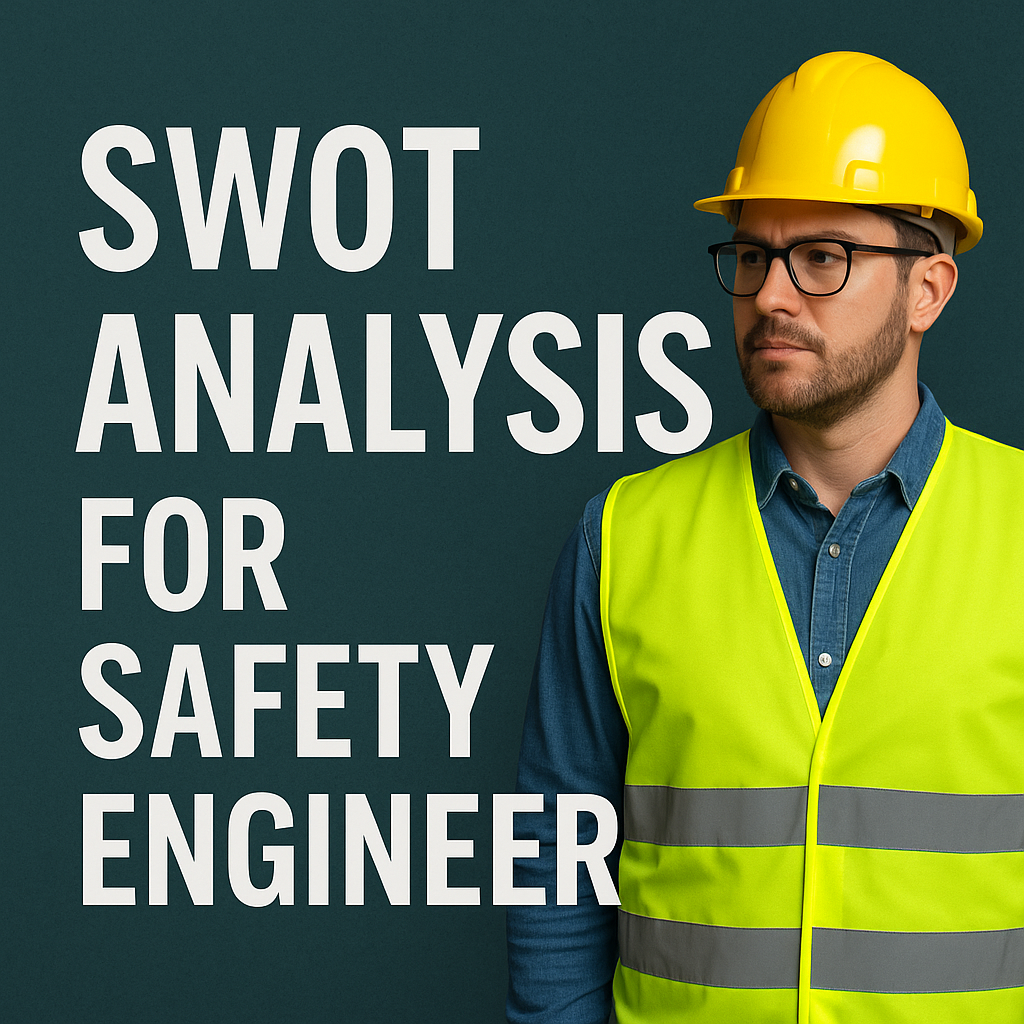
SWOT Analysis for Safety Engineer
Ever wondered why some safety engineers excel while others struggle to keep up with the demands of the job? It all comes down to understanding where you stand — and that’s where SWOT analysis becomes a game-changer.
SWOT stands for Strengths, Weaknesses, Opportunities, and Threats. It’s a powerful framework to evaluate yourself or your department and create a roadmap for improvement. In this guide, we’ll dive deep into what a SWOT analysis for safety engineers looks like — and how you can use it to build a thriving career in safety.
Strengths of a Safety Engineer
Technical Knowledge and Certifications
A certified safety engineer brings strong theoretical knowledge backed by certifications like NEBOSH, IOSH, OSHA, or CSP. These credentials are proof of your competency and make you stand out in the job market.
Regulatory and Legal Compliance Expertise
Understanding local and international safety regulations is a core strength. A good safety engineer ensures the workplace meets legal standards and avoids penalties or legal trouble.
Strong Communication and Training Skills
Whether it’s conducting toolbox talks or explaining hazards to workers, safety engineers must be clear, concise, and persuasive communicators.
Ability to Analyze Risk and Implement Controls
From HAZOP studies to risk assessments, your skill in identifying hazards and suggesting practical control measures helps keep lives safe and operations running smoothly.
Proactive Problem-Solving Mindset
Instead of waiting for an incident to occur, great safety engineers predict and prevent them. This proactive mindset saves time, money, and lives.
Weaknesses of a Safety Engineer
Over-Reliance on Protocol
Sometimes, blindly following rules without understanding the site’s unique conditions can make safety measures ineffective.
Limited Practical Exposure (for freshers)
New safety engineers may struggle to translate theoretical knowledge into real-world applications.
Communication Barriers with Non-Safety Staff
Using too much technical jargon or being overly strict can lead to poor relationships with operational teams.
Resistance to Organizational Change
Safety professionals can be seen as “rigid” if they don’t adapt to organizational priorities or are too risk-averse.
Burnout from High-Stress Environments
Being responsible for people’s lives 24/7 can cause mental fatigue and burnout, affecting performance and decision-making.
Opportunities for a Safety Engineer
Growing Demand in Industries
With stricter global safety norms, industries like construction, oil & gas, and pharmaceuticals are actively hiring safety engineers.
International Certifications and Global Exposure
Gaining globally recognized certificates can unlock overseas job opportunities with higher pay and better benefits.
Career Growth into Managerial Positions
Safety officers can rise to become Safety Managers, HSE Heads, or Compliance Directors by developing leadership and strategic thinking.
Networking and Professional Organizations
Being part of professional bodies like BCSP, IOSH, or ASSE provides learning opportunities, credibility, and career visibility.
Threats Faced by a Safety Engineer
Constantly Changing Regulations
Laws and compliance standards evolve rapidly — and failure to keep up can result in violations.
Budget Cuts and Cost-Driven Compromises
In some companies, safety budgets are trimmed, pushing safety down the priority list.
Lack of Safety Culture in Organizations
No matter how good you are, your efforts won’t work in an organization that doesn’t value safety.
High Responsibility with Legal Liabilities
In case of an accident, safety engineers can be held accountable, making it a legally risky role.
How to Use SWOT Analysis for Career Growth
Maximizing Strengths
Focus on what you do best. Keep sharpening your strong points through continuous education and mentorship.
Minimizing Weaknesses
Self-awareness is key. Identify your weak areas and seek training or guidance to improve them.
Seizing Opportunities
Stay updated with industry trends and certifications. Grab opportunities as they come — don’t wait.
Mitigating Threats
Be proactive about emerging risks — whether they’re technical, legal, or organizational.
Practical Example: SWOT Matrix of a Safety Engineer
| STRENGTHS | WEAKNESSES |
|---|---|
| Certified (NEBOSH, CSP) | Overly dependent on documentation |
| Excellent hazard identification | Struggles to connect with operations team |
| Strong audit and inspection skills | Limited hands-on field experience |
| OPPORTUNITIES | THREATS |
|---|---|
| Emerging safety technologies | Job cuts due to automation |
| Global safety certification demand | Fast-changing regulatory environment |
| Expansion into managerial roles | Weak safety culture in many organizations |
Tips to Continuously Improve as a Safety Engineer
Continuous Learning and Upskilling
Join webinars, workshops, or pursue diplomas. The safety field is always evolving — so should you.
Adapting to Industry Trends
Whether it’s ESG compliance or AI-powered inspections, being trend-aware gives you a competitive edge.
Effective Communication and Influence
Build your interpersonal skills. Influence comes not just from authority but from how well you connect with people.
Conclusion
SWOT analysis isn’t just a tool for companies — it’s a mirror for safety professionals. By recognizing your strengths, working on your weaknesses, jumping at the right opportunities, and preparing for potential threats, you create a safety career that’s future-proof, respected, and impactful.
Don’t wait for your next job interview to think about your capabilities — do your SWOT today and start building the safety leader you were meant to be.
10 Common Safety Mistakes Every HSE Officer Should Avoid
Top 5 Safety Tips for New HSE Professionals
Becoming a Safety Officer: A Step-by-Step Guide to Skills, Duties, and Compensation
Safety Manager Job Description: Key Duties, Skills, and Qualifications Explained
FAQs
1. What is the biggest strength of a safety engineer?
The ability to identify hazards and implement effective control measures, along with strong regulatory knowledge.
2. How can safety engineers overcome their weaknesses?
By engaging in continuous professional development, seeking mentorship, and getting more field exposure.
3. What are the most promising opportunities for safety engineers?
Technology integration, global certification, and leadership roles in expanding industries like renewable energy and infrastructure.
4. What are the key threats in the safety engineering profession?
Rapid regulatory changes, technological disruptions, and organizational resistance to safety improvements.
5. How often should a safety engineer conduct a SWOT analysis?
At least once a year or whenever there’s a major career change or project shift.